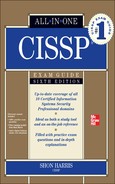Book Description
A complete, up-to-date revision of the leading CISSP training resource from the #1 name in IT security certification and training, Shon Harris. Well regarded for its engaging and informative style, CISSP All-in-One Exam Guide, Sixth Edition provides 100% complete coverage of the exam objectives for the Certified Information Security Specialist credentialing exam from (ISC)2. Updated to ensure total coverage of the latest body of knowledge and domains from (ISC)2, this new edition also provides references for government employees and contractors subject to new requirements.Exam tips highlight actual exam topics and technical discussion sidebars offer a level of instruction not found in other certification guides. The All-in-One also includes hands-on examples and exercises that reinforce practical learning and sample practice questions at the end of each chapter that test for comprehension and prepare you for each subject area or domain of the exam.
Book Description
A complete, up-to-date revision of the leading CISSP training resource from the #1 name in IT security certification and training, Shon Harris. Well regarded for its engaging and informative style, CISSP All-in-One Exam Guide, Sixth Edition provides 100% complete coverage of the exam objectives for the Certified Information Security Specialist credentialing exam from (ISC)2. Updated to ensure total coverage of the latest body of knowledge and domains from (ISC)2, this new edition also provides references for government employees and contractors subject to new requirements.Exam tips highlight actual exam topics and technical discussion sidebars offer a level of instruction not found in other certification guides. The All-in-One also includes hands-on examples and exercises that reinforce practical learning and sample practice questions at the end of each chapter that test for comprehension and prepare you for each subject area or domain of the exam.
Table of Contents
- Cover Page
- CISSP ALL IN ONE EXAM GUIDE, SIXTH EDITION
- Copyright Page
- ABOUT THE AUTHOR
- CONTENTS AT A GLANCE
- CONTENTS
- Foreword
- Acknowledgments
- Chapter 1 Becoming a CISSP
- Chapter 2 Information Security Governance and Risk Management
- Fundamental Principles of Security
- Security Definitions
- Control Types
- Security Frameworks
- Security Management
- Risk Management
- Risk Assessment and Analysis
- Risk Analysis Team
- The Value of Information and Assets
- Costs That Make Up the Value
- Identifying Vulnerabilities and Threats
- Methodologies for Risk Assessment
- Risk Analysis Approaches
- Qualitative Risk Analysis
- Protection Mechanisms
- Putting It Together
- Total Risk vs. Residual Risk
- Handling Risk
- Outsourcing
- Policies, Standards, Baselines, Guidelines, and Procedures
- Information Classification
- Layers of Responsibility
- Security Steering Committee
- Audit Committee
- Data Owner
- Data Custodian
- System Owner
- Security Administrator
- Security Analyst
- Application Owner
- Supervisor
- Change Control Analyst
- Data Analyst
- Process Owner
- Solution Provider
- User
- Product Line Manager
- Auditor
- Why So Many Roles?
- Personnel Security
- Hiring Practices
- Termination
- Security-Awareness Training
- Degree or Certification?
- Security Governance
- Summary
- Quick Tips
- Chapter 3 Access Control
- Access Controls Overview
- Security Principles
- Identification, Authentication, Authorization, and Accountability
- Access Control Models
- Access Control Techniques and Technologies
- Access Control Administration
- Access Control Methods
- Accountability
- Access Control Practices
- Access Control Monitoring
- Threats to Access Control
- Summary
- Quick Tips
- Chapter 4 Security Architecture and Design
- Computer Security
- System Architecture
- Computer Architecture
- Operating System Architectures
- System Security Architecture
- Security Models
- Security Modes of Operation
- Systems Evaluation Methods
- The Orange Book and the Rainbow Series
- Information Technology Security Evaluation Criteria
- Common Criteria
- Certification vs. Accreditation
- Open vs. Closed Systems
- A Few Threats to Review
- Summary
- Quick Tips
- Chapter 5 Physical and Environmental Security
- Chapter 6 Telecommunications and Network Security
- Chapter 7 Cryptography
- The History of Cryptography
- Cryptography Definitions and Concepts
- Types of Ciphers
- Methods of Encryption
- Types of Asymmetric Systems
- Message Integrity
- Public Key Infrastructure
- Key Management
- Trusted Platform Module
- Link Encryption vs. End-to-End Encryption
- E-mail Standards
- Internet Security
- Attacks
- Summary
- Quick Tips
- Chapter 8 Business Continuity and Disaster Recovery Planning
- Chapter 9 Legal, Regulations, Investigations, and Compliance
- The Many Facets of Cyberlaw
- The Crux of Computer Crime Laws
- Complexities in Cybercrime
- Intellectual Property Laws
- Privacy
- Liability and Its Ramifications
- Compliance
- Investigations
- Incident Management
- Incident Response Procedures
- Computer Forensics and Proper Collection of Evidence
- International Organization on Computer Evidence
- Motive, Opportunity, and Means
- Computer Criminal Behavior
- Incident Investigators
- The Forensics Investigation Process
- What Is Admissible in Court?
- Surveillance, Search, and Seizure
- Interviewing and Interrogating
- A Few Different Attack Types
- Cybersquatting
- Ethics
- Summary
- Quick Tips
- Chapter 10 Software Development Security
- Software’s Importance
- Where Do We Place Security?
- System Development Life Cycle
- Software Development Life Cycle
- Secure Software Development Best Practices
- Software Development Models
- Capability Maturity Model Integration
- Change Control
- Programming Languages and Concepts
- Distributed Computing
- Mobile Code
- Web Security
- Database Management
- Expert Systems/Knowledge-Based Systems
- Artificial Neural Networks
- Malicious Software (Malware)
- Summary
- Quick Tips
- Chapter 11 Security Operations
- Appendix A Comprehensive Questions
- Appendix B About the Download
- Glossary
- Index
